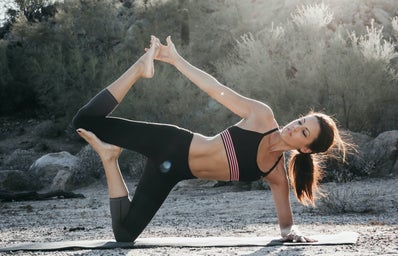Think of the last clothing, makeup, or haircare ad you saw. Did it depict a woman? Stylish, with silky soft hair or smoky eyes that popped off the page? Was she thin? Western media today portrays unrealistic ideals for women’s bodies that vary from what doctors deem healthy. With eating disorders on the rise, can elevated rates of bodily dissatisfaction be tied to media portrayal of beauty? My sources say yes; in fact, this idea of health sacrificing beauty may date back further than you think and relate more directly to eating disorders thank you know.
Let’s backtrack- haven’t eating disorders been around longer than New York Fashion Week and CoverGirl? Yes. Mery Miller and Andres Pumergia’s “Culture and Eating Disorders: A Historical and Cross Cultural Review,” a review of eating disorder symptoms completed in 2001, ties earliest evidence of deliberate food deprivation to ritual fasting associated with religious self-purification. In fact, in the renaissance era, many women were elevated to sainthood for what Rudolf Bell called “Holy Anorexia,” self-starvation for a purpose greater than themselves.
Perhaps these examples can be written off as spiritually-impassioned acts of religious devotion rather than eating disorders. But, consider a trend that dates back to the 16th century: the corset. Regardless of the time or place, this staple of aristocratic fashion had a simple goal- to show off the voluptuousness of a woman’s body. You may ask, “How does this relate to eating disorders?” Directly, it may not, but the nature of women sacrificing their own health to meet societal staples of attractiveness is consistent.
The constricted nature of the corset forced women wearing them to take shallow breaths into the upper part of their lungs. Some women abstained from eating before major events to ensure the corset be as tight as possible. Combine the two, and you get a recipe for faint women choosing to prime their aesthetic appeal over their physical health. Sound familiar?
Now, how do these historical trends manifest today? Remember the advertisement you visualized a few minutes ago? Our standard of “pretty” in Western society is set by the media.
A study by Barbara Frederickson published in 1998 developed Objectification Theory, which determines American culture to be the frame to which women compare their own bodies. The study tested the effects of experimentally induced self-objectification, and found that media images of ideal bodies result is body shame and restrained eating among women more often than men.
A similar study published in 2008, conducted in Australia by Brit Harper and Marika Tiggemann, tested the effects of media images on self-objectification in women. Study participants exposed to media-idealized standards of thinness reported greater bodily dissatisfaction than participants exposed to product control advertisements.
So, what can we conclude? Portrayals of feminine beauty in advertisements for hair care, cosmetic products, or even diet plans tend to revolve around supermodels of weights much lower than the healthy weight of an average woman. The result? Frederickson and Harper’s studies indicate that the massive revenue streams for companies flooding markets with unrealistic images of attractiveness essentials come from women diminishing themselves, physically and emotionally, to meet them.
This begs the question, who is most at risk? A study by Mandy McCarthy gathered statistics on eating disorders, depression, and cross over between the two. McCarthy’s study suggests that adolescent girls who display mild depressive symptoms, even before they can consciously communicate societal standards of beauty, are most susceptible to developing an eating disorder during or shortly after puberty.
From a girl’s perspective, this is only logical. If eating disorders rise from bodily insecurities, then why not try to look like the pretty, happy, skinny women in beauty advertisements? Disordered eating leads to weight-loss and a self-esteem boost that band-aids the insecurity but fails to address the root of the problem. Before, the insecurities were aided in weight loss, so why not lose more? The effects snowball into a cycle of obsessive-compulsive eating tendencies on top of mounting bodily insecurity and health risks.
McCarthy hypothesizes that the self-esteem issues that give rise to disordered eating stem from a lack of autonomy, which leads to desired identification with societal ideals of beauty. The cure? On a broad level, change in cultural ideals of a woman’s beauty. On an individual level, a heavy dose of girl power and strengthening of personal identity to help increase happiness in one’s own skin and lessen the need to identify with the impossible picture our society paints of perfectly pretty.
Sources
Burns, P. D. (2017, July 29). History of Corsets for Women. Retrieved October 6, 2018, from
https://bellatory.com/fashion-industry/History-Of-Womens-Corsets
Frederickson, B.L., Roberts, T., Noll, S. M., Quinn, D. M., & Twenge, J. M. (1998). That
Swimsuit Becomes You: Sex Difference in Self-Objectification, Restrained Eating, and
Math Performance. Journal of Personality and Social Psychology, 75(1), 269-284.
Harper, B. & Tiggeman, M. (2008) Sex Roles, 58: 649. https://doi.org/10.1007/s11199-007-9379-x.
McCarthy, M. (1990). The thin ideal, depression and eating disorders in women. Behaviour
Research and Therapy,28(3), 205-214. doi:10.1016/0005-7967(90)90003-2
Miller, M. N., & Pumariega, A. J. (2001). Culture and Eating Disorders: A Historical and Cross-
Cultural Review. Psychiatry: Interpersonal and Biological Processes,64(2), 93-110. doi:10.1521/psyc.64.2.93.18621


